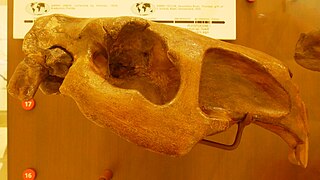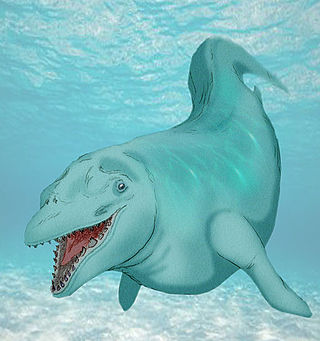Related Research Articles

Synaptomys is a genus of North American lemmings. These animals live in wet forested and open areas. They are small, cylindrical rodents with large heads and short ears, legs, and tails. They eat green vegetation such as grasses and sedges. They are often found in colonies.

Entelodon, formerly called Elotherium, is an extinct genus of entelodont artiodactyl endemic to Eurasia. Fossils of species are found in Paleogene strata ranging in age from the Houldjinian until the Rupelian epoch of the early Oligocene.

Neochoerus is an extinct genus of rodent closely related to the living capybara. Fossil remains of Neochoerus have been found through North America and South America in Boyacá, Colombia.

Pantolambda is an extinct genus of Paleocene pantodont mammal. Pantolambda lived during the middle Paleocene, and has been found both in Asia and North America.

Ailuravus is a genus of prehistoric rodents in the family Ischyromyidae.
Zanclites is an extinct genus of prehistoric ray-finned fish.

Tomarctus is a canid genus of the extinct subfamily Borophaginae which inhabited most of North America during the late Early Miocene to the Early Barstovian age of the Middle Miocene. Tomarctus existed for approximately 6.83 million years.

Procolpochelys is an extinct genus of sea turtle from the Miocene of what is now Maryland, Virginia, and New Jersey. Its fossils have been found in the Calvert Formation. It was first named by Hay in 1908.
Simocetus is an extinct genus of toothed whale that lived during the Oligocene period, approximately 32 million years ago, making it the oldest named toothed whale, although older unnamed toothed whales exist.
Astrohippus is an extinct member of the Equidae tribe Equini, the same tribe that contains the only living equid genus, Equus. Fossil remains have been found in the central United States, Florida, and the Mexican states of Chihuahua, Jalisco, and Guanajuato. The fossils date in time from the oldest dating from the Barstovian in the Miocene to the youngest dating in the Hemphillian faunal stage of the early Pliocene.
Dianosuchus is an extinct genus of protosuchid crocodyliform. Fossils have been found from the Dark Red Beds of the Lower Lufeng Formation in Yunnan, China, dating back to the Sinemurian stage of the Early Jurassic. It is characterized by an unusually flattened snout compared to other protosuchians, conical isodont teeth that lacked striations, and very small antorbital fenestrae.
Kyasuchus is an extinct genus of shartegosuchid crocodyliform. Fossils have been found from the Ilek Formation outcropping in the Kemerovo Oblast of Russia, deposited during the Aptian and Albian stages of the Early Cretaceous. The localities from which specimens of this genus have been found have also yielded many other vertebrate remains such as those of palaeonisciform fishes, turtles, various lizards, troodontids, triconodonts, the ceratopsian Psittacosaurus, and the protosuchian-grade crocodylomorph Tagarosuchus.
Hypsamasia is an extinct embrithopod mammal that lived during the middle Eocene. Dental remains of this herbivore have been found in the Kartal Formation near the village Saribeylar north of Ankara in what is today Anatolia.
Kinkonychelys is an extinct genus of side-necked turtle which existed in Madagascar during the Late Cretaceous period. It contains the single species Kinkonychelys rogersi, named in honor of its discoverer, Raymond R. Rogers. The genus and species are based on UA 9748, a nearly complete skull, which represents the first turtle skull described from the pre-Holocene era in Madagascar. A number of isolated skull and jaw bones have also been assigned to K. rogersi. These specimens were found in rocks of the Maastrichtian-age Maevarano Formation in the Mahajanga Basin of northwestern Madagascar. Another specimen, FMNH PR 2446, is speculated to represent another species, currently known as Kinkonychelys sp., but consensus on its distinction from K. rogersi remains unclear.
Concavodontinae is an extinct subfamily of prehistoric bivalves in the family Praenuculidae. Concavodontinae species lived from the middle Ordovician, Caradoc epoch through the late Ordovician Ashgill epoch. Concavodontinae fossils are found in Europe and South America, and species are thought to have been stationary attached to substrate in shallow infaunal marine water environments where they formed shells of an aragonite composition. The subfamily Concavodontinae was named by Teresa M. Sánchez in 1999.

Albertogaudrya is an extinct genus of astrapotherian mammal that lived in present-day Patagonia and Salta, Argentina during the Eocene 48.6 to 37.2 million years ago. Fossils of Albertogaudrya have been found in the Lumbrera and Sarmiento Formations. It is named after French palaeontologist Albert Gaudry.

Pappocetus is an extinct protocetid cetacean known from the Eocene of southern Nigeria's Ameki Formation and Togo. More recently, fossil teeth and femurs have also been discovered in the Aridal Formation of the Sahara Desert in southwestern Morocco.

Masracetus is an extinct genus of basilosaurid ancient whale known from the Late Eocene of Egypt.

Tasbacka is an extinct genus of sea turtle containing several species.
Llullataruca is an extinct genus of macraucheniid litoptern. It lived during the Middle Miocene of what is now Bolivia.
References
- ↑ The Paleobiology Database Accessed on 12/07/08
- ↑ Waagenoceras info
- 1 2 Paleobiology Database